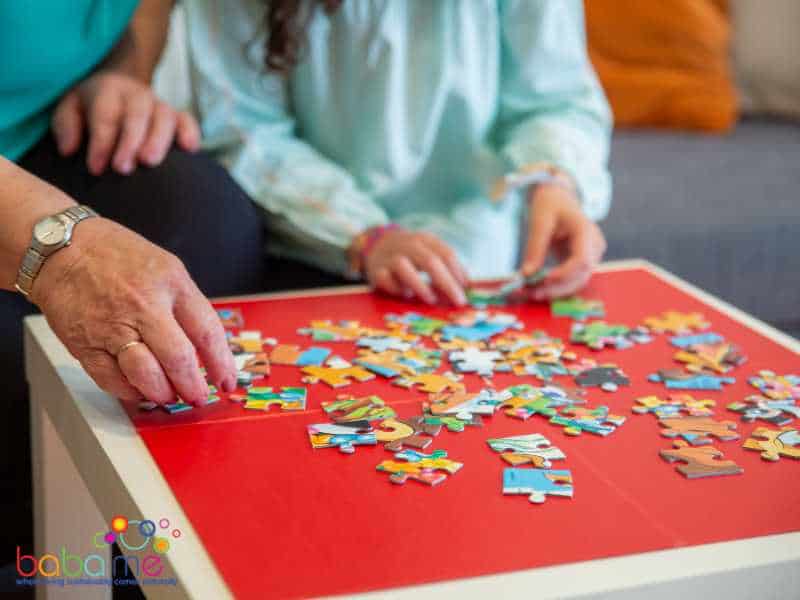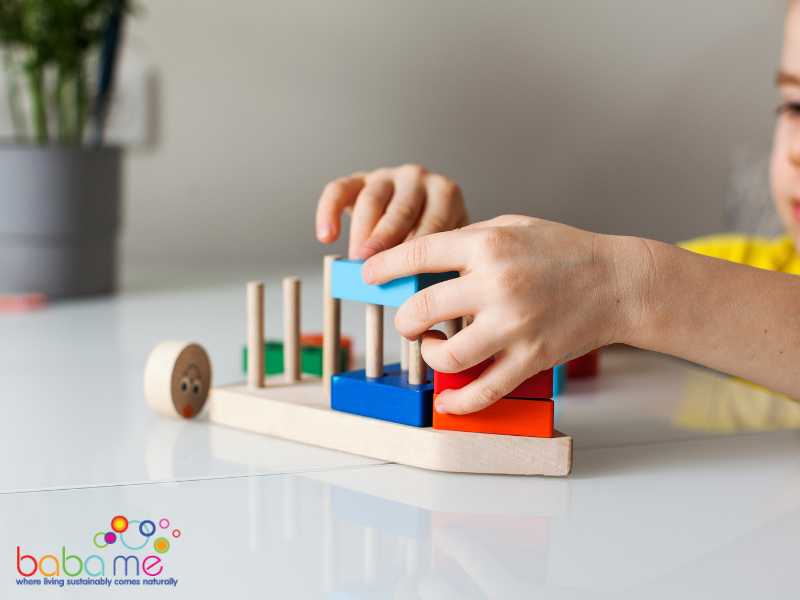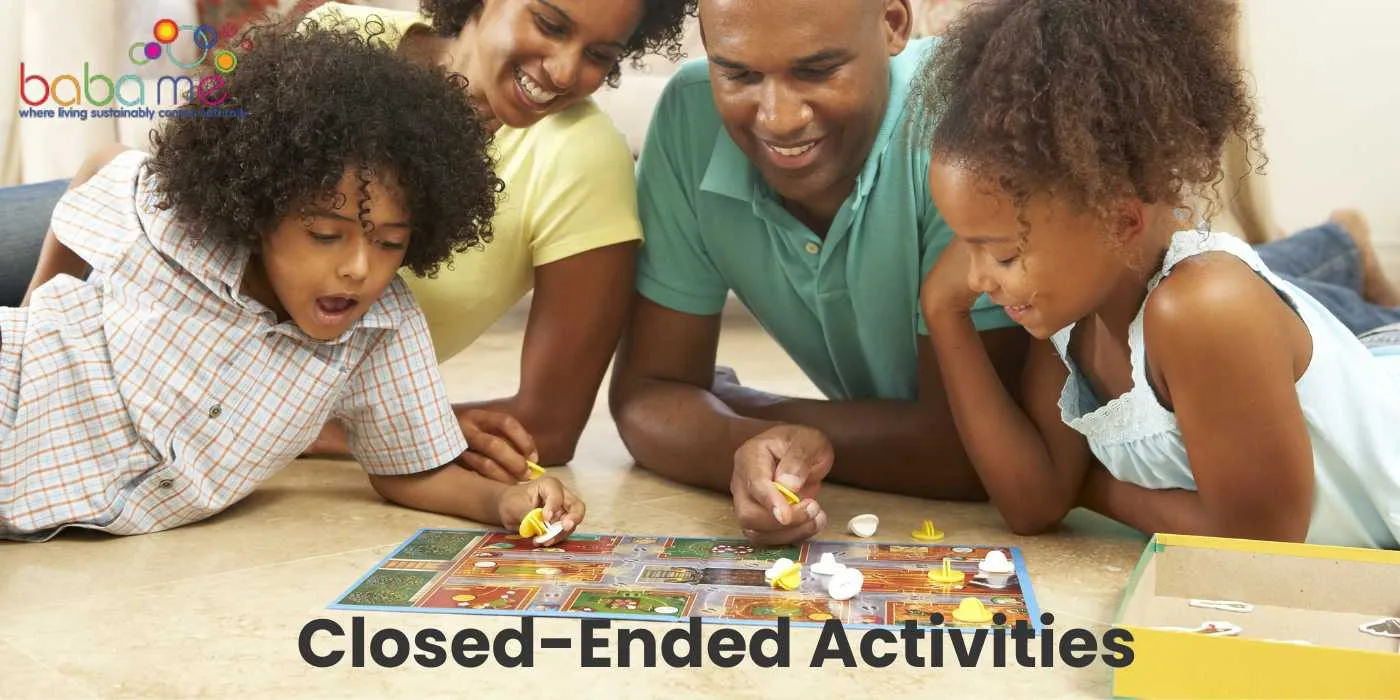Closed-ended activities are structured tasks with a clear beginning and end, often leading to a specific outcome or answer. Unlike open-ended activities that encourage exploration and have multiple outcomes, closed-ended activities are more about reaching a predetermined goal or solution.
From enhancing problem-solving abilities to fostering attention to detail, closed-ended activities offer numerous benefits that can set the foundation for a child’s cognitive growth.
Key Takeaways: Closed-Ended Activities
- Closed-ended activities have predefined outcomes. These activities are structured with specific goals and results in mind.
- Closed-ended activities are excellent for teaching specific skills. Because of their structured nature, closed-ended activities are useful for focused skill development.
- Closed-ended tasks facilitate easier assessment. The clear objectives of these activities make it straightforward to evaluate performance.
- Closed-ended activities offer a sense of accomplishment. Completing these activities provides a clear sense of achievement due to the defined end-goal.
- Closed-ended activities often require less creativity. These tasks usually follow a set pattern or guidelines, limiting the need for creative input.
- Closed-ended activities are time-efficient. With a clear endpoint, these activities are often more time-bound and predictable.
- Closed-ended activities can be less stressful for participants. The clarity of expectations and outcomes can reduce anxiety and stress.
- Closed-ended activities are ideal for beginners in a new skill area. The structured approach provides a solid foundation for learning new skills.
Understanding Close Ended Activities
If you’re looking for activities that have a definitive end, then close-ended activities are the perfect choice for you. Close-ended activities are those that have a clear objective or outcome, and once that objective is achieved, the activity is complete.
These activities are perfect for building attention and focus in young children and can help them understand the concept of task completion.
Close-ended activities come in many forms, such as puzzles, shape sorters, and board games. These activities have a clear set of rules and a specific goal to achieve.
Once the goal is achieved, the activity is complete. This type of activity is perfect for children who struggle with attention and focus because it provides a clear endpoint and helps them stay engaged until the task is complete.
One of the benefits of close-ended activities is that they provide a sense of accomplishment and satisfaction once the task is completed. This can help boost a child’s self-esteem and confidence, which can have a positive impact on their overall development.
Another benefit of close-ended activities is that they can be used to teach important skills such as problem-solving, critical thinking, and decision-making.
For example, a puzzle requires a child to think critically about how the pieces fit together and make decisions about which pieces to use to complete the puzzle.

Benefits of Close Ended Activities
Close-ended activities can be incredibly beneficial for both children and adults. Here are some of the benefits of incorporating close-ended activities into your daily routine:
Sense of Pride
When you complete a closed-ended activity, you get a sense of pride and accomplishment. This is especially true for children who are still developing their sense of self-esteem. Completing a puzzle, finishing a craft project, or solving a maze can all give children a sense of pride and boost their confidence.
Task Completion
Close-ended activities have a clear beginning and end, which makes it easier to stay focused and complete the task at hand. This is especially helpful for children who struggle with attention and focus. By completing a closed-ended activity, they learn the satisfaction of finishing a task and can build on that success with more complex tasks.
Shorter Routines
Closed-ended activities can be completed quickly, making them ideal for shorter routines. For example, you can use a puzzle or shape sorter as a quick activity to keep your child engaged while you prepare dinner. This can also be beneficial for adults who have limited time but still want to engage in a meaningful activity.
Incorporating closed-ended activities into your routine can have numerous benefits. From boosting self-esteem to improving attention and focus, these activities can be a valuable addition to your daily routine.

Structured play activities and closed-ended activities
Structured play activities and closed-ended activities are related concepts often used in the field of early childhood education and play therapy, but they do have key differences:
Structured Play Activities
Structured play activities are those in which the parameters of play are clearly defined and usually guided by an adult or set of rules. They involve specific instructions and the goal is to complete the task at hand, following a series of predetermined steps.
Examples include board games with set rules, dance or music classes with clear instructions, or team sports with defined roles and regulations. Structured play can help children learn about following directions, working as a team, and respecting rules, and it often develops specific skills such as motor abilities or problem-solving.

Closed-Ended Activities
Closed-ended activities are those with a clear ending or result. Once a task is accomplished or a specific goal is reached, the activity is completed. These activities often have a “right” or “wrong” way to be performed or have specific outcomes.
For example, a jigsaw puzzle is a closed-ended activity as there is a clear endpoint when the puzzle is finished, and it must be done in a specific way for the pieces to fit together. Another example could be a craft project where children are asked to recreate a specific model.
So the main difference lies in the flexibility and possible outcomes of the activities. While structured play activities can still allow for some degree of creativity and can have multiple outcomes (for example, a structured dance class can still enable children to create their own dances), closed-ended activities have one determined end result and a correct way to reach it.
On the other hand, both types of play offer children the opportunity to learn and practice new skills, follow instructions, and work towards achieving a goal.
Open Ended Play vs Close Ended Play
| Open-Ended Play | Closed-Ended Play | |
|---|---|---|
| Definition | Play that does not have a specific end goal and allows children to use their imagination and creativity freely. | Play that has a definite conclusion or a specific goal that is to be achieved. |
| Examples | Building with blocks without instructions, imaginative play with dolls or action figures, creating art with paints or clay. See open ended activities here. | Completing a puzzle, playing a board game with set rules, following a recipe or specific craft instructions. |
| Skills Developed | Creativity, imagination, problem-solving, self-expression, social skills. | Goal setting, following instructions, patience, persistence, specific skill sets depending on the activity (e.g., fine motor skills in crafting). |
| Level of Adult Intervention | Usually minimal. The child leads the play and adults may join in or facilitate. | Usually high. Adults typically explain the rules or steps and might monitor progress and quality of outcomes. |
| Flexibility | Very flexible. The child can change the rules, roles, or outcomes at any time. | Not very flexible. The rules and goals are typically set and don’t change during the activity. |
| Outcome | No set outcome. The value lies in the process rather than the product. | Clear and expected outcome. The value often lies in the finished product or achieving the goal. |
FAQS on Close Ended Toys
What is the difference between open-ended toys and close-ended toys in a Montessori classroom?
In a Montessori approach to learning, both open-ended and close-ended toys have their unique advantages – but montessori doesn’t suit all children. Open-ended toys like blocks or doll houses allow for independent play, encouraging kids to explore endless ways to use the material and fostering pretend play, which is crucial for developing emotional intelligence and social skills.
Close-ended toys have a specific objective you have your child complete, such as puzzle pieces that only fit in the right orientation. This helps children to develop attention, build their visual memory and gain the ability to self-correct. They often require multiple steps and give a specific outcome, aiding in the development of logical thinking and problem-solving abilities.
How do close-ended toys help a child learn and develop?
Close-ended toys are designed with a specific purpose in mind. For instance, a puzzle requires a child to put pieces together in a specific way, with one piece fitting into another in the right orientation. This not only helps develop attention to detail but also enhances visual memory as the child tries to remember the correct placements. The child learns to be patient as they work towards a specific outcome. The process of self-correction when a piece doesn’t fit builds resilience and determination.
Why are Montessori toys often close-ended, and how does this build a child’s attention span?
Montessori toys, unlike conventional ones, are often close-ended with a specific objective to achieve. This is because the Montessori approach values the idea that learning comes from doing and accomplishing tasks. When a child completes a task that a close-ended toy offers, they get a sense of achievement that builds their confidence. This repeated process of focusing on a task until it is completed effectively builds a child’s attention span. The concentration required to achieve the specific outcome trains the child’s mind to stay engaged for longer periods.





